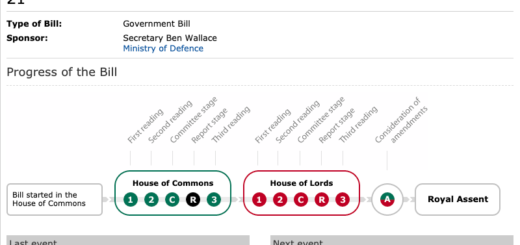Soleimani strike “unlawful”
A recent investigation and report by the UN’s special rapporteur on extrajudicial, summary and arbitrary executions, Dr Agnes Callamard, finds the US killing of Iranian General Qassem Soleimani “unlawful” and an “escalation.” Drawing on all available evidence, the report states that: “the targeting of General Soleimani, and the deaths of those accompanying him, constitute an arbitrary killing for which, under IHRL [international human rights law], the US is responsible.”
A swift analysis of the legal frameworks that may be applicable concludes that the drone strikes were in violation of Article 2(4) of the UN Charter - which “prohibits the threat or use of force and calls on all Members to respect the sovereignty, territorial integrity and political independence of other States.” The US’ failure to provide sufficient evidence of an ongoing or imminent attack and failure to gain permission from Iraq to conduct said strikes, meant it violated Iraq’s sovereignty. The report also finds that “the strikes against General Soleimani and the US bases in Iraq resulted in far more casualties than their direct targets alone.” The report, which focuses on the legality of armed drones, calls for increased accountability, oversight and regulation over the developing, exports and use of drones.
An unprecedented escalation
The strikes that killed Soleimani represent a “watershed change,” both in terms of the identity of the target and location of the strike, and flies in the face of international law. “For the first time, in January 2020, a state armed drone targeted a high-level official of a foreign state on the territory of a third one - a significant development and an escalation.”
Dr Callamard warns that the international community now confronts the prospect of states “strategically” killing high-level military officials outside “known” armed conflicts, justified by classifying the individual as a “terrorist” posing a possible, yet undefined, future threat. The strikes came in the “wake of 20 years of distortions of international law, and repeated massive violations of humanitarian law, [this] is not just a slippery slope. It is a cliff.”
Debunking “the myth of the surgical strike”
Armed drones are neither inherently more precise, nor do they by design provide better protection for civilians. Citing research by APPG on Drones expert, Dr Larry Lewis and civil society investigations, the report shows how drone strikes have caused more civilian casualties than conventional strikes,[i] and highlights significant failures to acknowledge the actual number of deaths caused. In fact, “[t]he intelligence gathering and complex coordination required across teams, agencies and countries, diffusion of controls over visuals, and other factors increase the risks of inaccuracy in use, if not actual misuse, of drone technology.” This, the Special Rapporteur concludes, means that in practice, “the potential for human error and thus imperfect instruction of the drone is far higher than usually acknowledged.”
Civilian harm
A drone strike is only as precise as the intelligence that informs it. The Special Rapporteur highlights major problems pertaining to identifying a target, a process which is “often reliant on complex networks of informers and analyst, with each commonly convoluted and speculative”, stating: “Mistakes are inevitable.” Even when a drone hits its intended target “accurately and ‘successfully’,” evidence shows that strikes frequently kill many more people than the intended target. “Those casualties may well amount to violations of international humanitarian and/or human rights law.”
Research conducted on drone strikes in Yemen underline the human cost of incorrect intelligence.[ii] During repeated attempts to target eighteen men, drone strikes killed 273 other people, accounting for almost half of all confirmed civilian casualties and 100 percent of all recorded child deaths.[iii]
Furthermore, civilian harm caused by armed drones extends beyond deaths and injuries. Evidence shows that drones cause persistent and daily terror for the people living under them.[iv] “The strain of constant anticipation of a drone attack[v], cause significant psychological harm, including PTSD[vi], cripple daily activities[vii] and create largely unaccounted for socio-economic burdens, particularly on women[viii].”
Mitigating civilian casualties
In armed conflicts, the number of civilian casualties has been reduced through stronger coordination, improved data analysis, better training of drones’ operators, and systematic evaluation of strikes.[ix] NATO’s 2018 Protection of Civilians Strategy and Concept; and Policy are examples. The strategy introduced civil-military coordination teams responsible for recording and investigating allegations. Through a civilian harm mitigation “life cycle,” civilian protection is integrated at all points during the planning and use of military force. In addition, systematic reviews of incidents of civilian deaths are crucial to detect or prevent operational deficiencies.[x] “The Special Rapporteur strongly encourages such measures which should include robust investigations into possible violations of international law”[xi].
Oversight, accountability and regulation
“[T]he evidence continues to suggest that drone operations are … characterized by violations of the international obligation to investigate, and to punish, where applicable, those responsible for violations of international humanitarian or human rights law.” This coupled with states’ failure to disclose information to the public,[xii] has wrapped the investigation of civilian deaths in secrecy.
Over the years, courts have largely refused to oversee the use of drones to kill individuals extraterritorially, arguing that this is a political matter, or relating to international relations between states, and as such is non-justiciable. A blanket denial of justiciability, Callamard argues, “cannot be reconciled with recognised principles of international law, treaties, conventions and protocols, and violates the rights to life and to a remedy.”
In order to be lawful, a drone strike has to conform to three bodies of law: the law of self-defence, international human rights law and international humanitarian law. However, up until today, drone strikes have rarely been held to account. Three changes are required to facilitate meaningful accountability:
- The international community must develop robust international standards governing the development, export and use of drones, and; States and the UN must be willing to engage with “self-defence” justifications brought forth by States;
- Parliaments in countries that produce, export and use drones must play a more active role in approving and scrutinising the lethal use of drones. This requires stricter controls on the transfer of military and dual-use technology;
- Courts must be prepared to declare that a State’s human rights treaty obligations can apply in principle to its conduct outside its own territory, and that strikes, and their targets, should be considered within the jurisdiction of the State operating the drone.
Next steps
The proliferation and increased use of armed drones “reflects a race for armaments which presents extraordinary risks for us all.”[xiii] This race, “is taking place in the midst of persistent and repeated attacks against basic principles of humanity.”[xiv] Parties to conflicts routinely target hospitals and schools, whilst human rights defenders, dissidents and journalists “in exile do not find safety abroad.” The weakening of the international rules-based order has significant global consequences. For the UK, it is fundamental to our security and prosperity, as set out in numerous policy documents over the past decades. The changing nature of modern conflict, in particular the use of remote warfare; explosive weapons in urban areas; operations conducted outside armed conflicts, and; partner and coalition work, calls for a recommitment to international obligations and laws.
The UK, as the penholder on civilian protection at the UN Security Council, coupled with the Government’s commitment to “championing the international rules-based order”; the development of a new integrated defence, security and foreign policy,[xv] and; the establishment of the Global Human Rights Sanctioning Regime, has an opportunity to champion adherence to international law on the global stage. This effort should be complimented by UK leadership by example, through publishing a robust and transparent civilian protection strategy; – including prevention, mitigation, recording and investigation provision - and a commitment to subject all military activities to parliamentary oversight.
What can parliamentarians do?
- Call for the UK to sign onto the upcoming political declaration to address the humanitarian harm arising from the use of explosive weapons in populated areas;
- Take on the Special Rapporteur’s recommendation to Parliaments to advocate for the establishment of “parliamentary and judicial mechanisms to oversee, review and/or approve a State’s use of lethal force, domestically and extraterritorially,” and ensure that oversight mechanisms are designed to “keep pace with technological and weapons developments”;
- Similarly, following on from the Public Administration and Constitutional Affairs Committee’s Inquiry into Parliament’s role in authorising the use of military force, take steps to:
- strengthen Parliament’s ability to hold the government to account and ensure it “meaningfully uphold its obligations under the conventions” as “Britain’s growing military capabilities and commitments are far outpacing the existing procedures for parliamentary scrutiny and oversight”;
- improve parliamentary oversight by considering “the principle of how special forces and drones are utilised … even if specific instances of deployment cannot be debated openly. This would both hold the Government to account for its general policy and give the Government guidance in relation to the types of policy which the House of Commons would, in principle, tolerate and support. (Paragraph 119).”
- Call to on the Government provide parliamentarians with insight into, and widely consult with Members, civil society and experts on the Integrated Defence, Security and Foreign Policy Review;
- Call for insight into the development of the updated UK Strategy on Protecting Civilians; for the Strategy to include comprehensive prevention, mitigation, tracking and recording provisions; and for the FCO to consult with Parliamentarians, civil society and experts;
- Call for the UK to take a more active role on the international stage in championing the adherence to international law; for the UN Security Council to systematically communicate to the General Assembly all reports received by States intending to use force in “self-defence” (Art. 51); and promote increased international oversight and accountability on the development, export and use of armed drones, military equipment and dual-purpose equipment;
- Scrutinise the government’s military activity, including all forms of assistance to partners, and call on the government ensure that this action does not violate international law.
Endnotes
[i]https://www.cna.org/cna_files/pdf/COP-2014-U-008746-Final.pdf; Analysis of classified data on U.S. drone strikes in Afghanistan from 2010 to 2011 reveals that drone strikes had been ten times more likely to cause civilian casualties than conventional air attacks. Dr Larry Lewis, CNA
[ii] Camilla Molyneux, The human cost of remote warfare: silenced narratives, upcoming, January/TBC 2021; Baraa Shiban and Camilla Molyneux, the human cost of remote warfare in Yemen, Oxford Research Group, July/TBC 2020; https://reprieve.org/wp-content/uploads/2014_11_24_PUB-You-Never-Die-Twice-Multiple-Kills-in-the-US-Drone-Program-1.pdf
[iii]https://reprieve.org/wp-content/uploads/2014_11_24_PUB-You-Never-Die-Twice-Multiple-Kills-in-the-US-Drone-Program-1.pdf
[iv] Camilla Molyneux, The human cost of remote warfare: silenced narratives, upcoming, January/TBC 2021; Baraa Shiban and Camilla Molyneux, the human cost of remote warfare in Yemen, Oxford Research Group, July/TBC 2020
[v] https://www-cdn.law.stanford.edu/wp-content/uploads/2015/07/Stanford-NYU-Living-Under-Drones.pdf; http://www.christopherjferguson.com/Drones.pdf.
[vi] http://www.christopherjferguson.com/Drones.pdf.; Camilla Molyneux, The human cost of remote warfare: silenced narratives, upcoming, January/TBC 2021
[vii] https://www.files.ethz.ch/isn/196761/Drone%20Chic%20Briefing%20April%202016.pdf; https://www.theatlantic.com/international/archive/2013/04/living-in-terror-under-a-drone-filled-sky-in-yemen/275373.; Camilla Molyneux, The human cost of remote warfare: silenced narratives, upcoming, January/TBC 2021
[viii] Kennedy-Pipe, C. et. al. Terrorism and Political Violence, 2016; Camilla Molyneux, The human cost of remote warfare: silenced narratives, upcoming, January/TBC 2021
[ix] Larry Lewis, Protecting Medical Care in Conflict, 2019.
[x] Larry Lewis, Improving lethal Action, September 2014.
[xi]https://www.geneva-academy.ch/joomlatools-files/docman-files/Guidelines%20on%20Investigating%20Violations%20of%20IHL.pdf .
[xii] https://civiliansinconflict.org/wp-content/uploads/2020/02/PDF-Report-for-Website.pdf.
[xiii] https://www.aljazeera.com/news/2020/07/qa-agnes-callamard-drone-strike-killed-soleimani-200711080404877.html
[xiv] https://www.aljazeera.com/news/2020/07/qa-agnes-callamard-drone-strike-killed-soleimani-200711080404877.html
[xv] Integrated Defence Security and Foreign Policy Review




